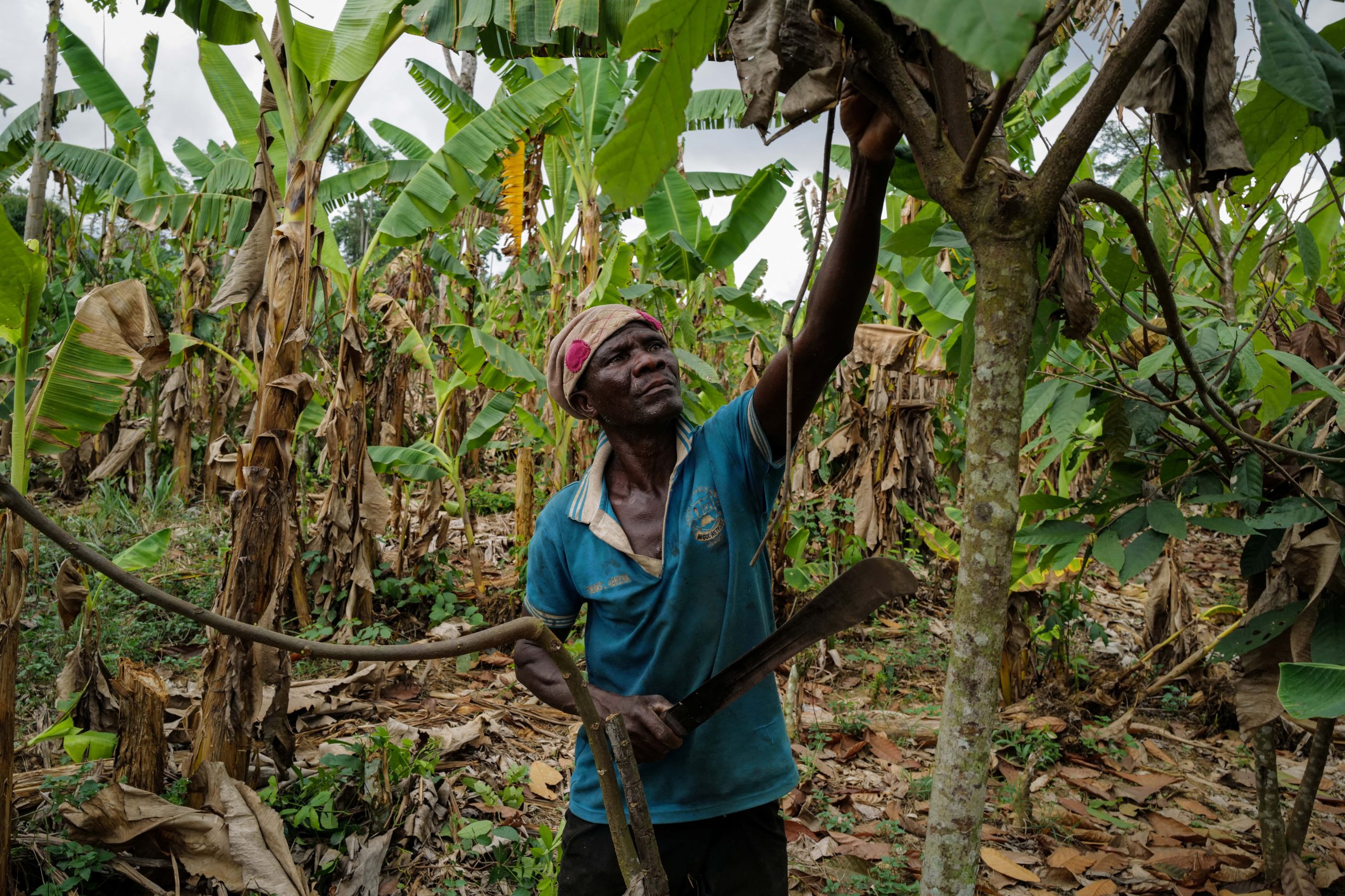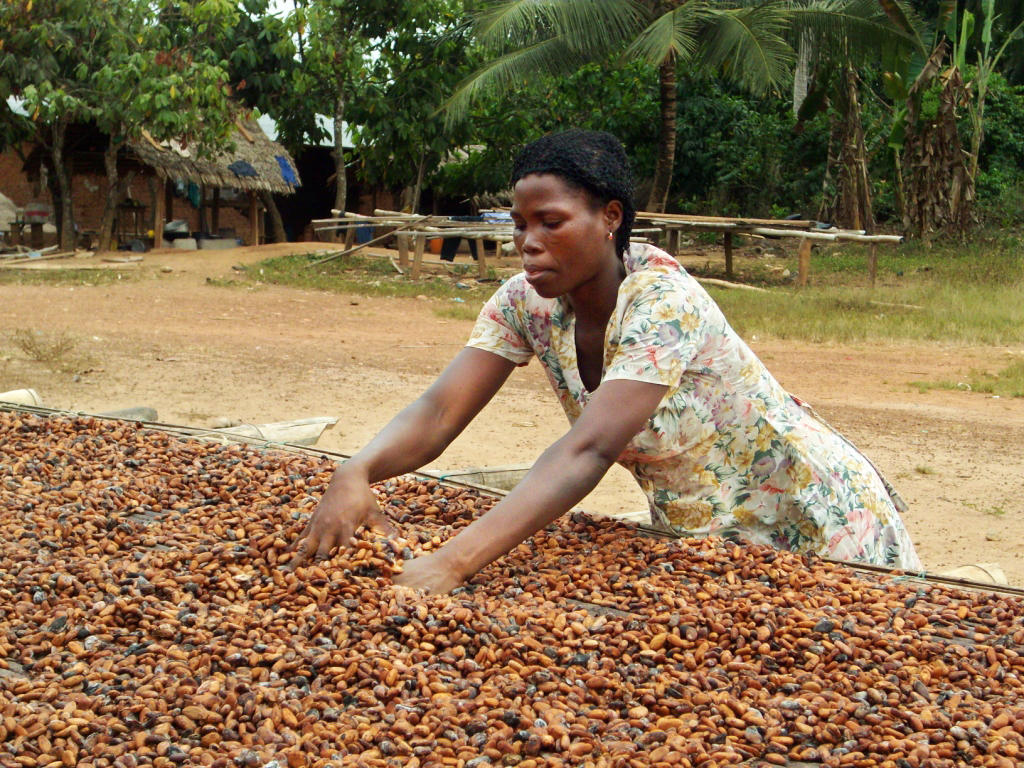Chocolate isn’t just a sweet treat – it’s a global industry worth over $100 billion per year and a crucial lifeline for millions of farmers in developing countries who grow its main ingredient: cocoa beans.
But recent price spikes mean the commodity has become a flashpoint for wider concerns about the impact of climate change on agriculture and the need to shift to more sustainable farming.
For such a widely consumed product, the cocoa bean requires a surprisingly unique set of conditions in which to grow. Cocoa trees only survive within a belt 20 degrees north or south of the Equator and at an altitude with a consistent, humid climate and plenty of rain.
Around 50 countries meet these exacting conditions, and they account for the vast majority of all cocoa production. West Africa, in particular, is a hotspot, with Ghana and Ivory Coast producing 60-70% of all the world’s cocoa.
“Smallholder cocoa farmers in West Africa are the backbone of the chocolate industry, yet they remain at the losing end of the supply chain,” said Ghana-based Kwame Osei, senior director for global programmes at the Rainforest Alliance, an international nonprofit that works to protect forests through responsible business.
The price of cocoa has skyrocketed as a result of intense heat and rainfall in West Africa, which has greatly reduced crop yields, as shown in data by the International Cocoa Organization.
While the rise in cocoa prices might seem like good news for farmers in the region, Osei noted that they receive on average only 6% of a chocolate bar’s retail price. In recent years, they have struggled with the impacts of climate change, to which their crop is highly susceptible.
The price per tonne for cocoa on the futures market has doubled since the start of the year, reaching over $10,000 for the first time. In the longer term, higher prices could boost farmers’ incomes, experts say – if the right policies are put in place.
Both Ghana and Ivory Coast have recently increased the fixed price producers receive for their crop before export by over 50%, albeit from a low base. But long-term changes are needed for the industry to go green, sector experts told Climate Home.
Currently, the risk is that market volatility linked to extreme weather could drive money away from the sector. Companies seeking to develop cocoa alternatives, for example, have attracted investment of $51 million since the start of 2023, according to recent research from data firm New Food Finance.

Boamah Sonkaa, a cocoa farmer, visits his cocoa farm near the village of Kusa, in the Ashanti region of Ghana, August 27, 2022. (Photo: Francis Kokoroko/Reuters)
Wrong incentives
The upheaval in the market has highlighted the need to adapt cocoa production to a warming world while at the same time reducing the industry’s environmental impacts. Current incentives enable deforestation and water depletion – and need to be changed to support greener practices, the experts said.
Subsidies come in different forms – whether as direct payments and tax breaks, or indirectly through external social and economic impacts. Both types of subsidy combined exceeded $7 trillion in 2023, covering fossil fuels, agriculture and fisheries, according to a 2023 World Bank Report.
Direct subsidies for the agricultural sector add up to $635 billion a year, it notes. They mainly support the use of fossil fuel-based fertilisers and intensive cultivation of cash crops for export, which are contributing to rising emissions of planet-heating gases.
In the case of cocoa, the report suggests that in Ivory Coast, increasing subsidies to the industry drove deforestation, as farmers cleared more land to grow trees along the border between Ivory Coast and Ghana. The analysis shows that, between 2000 and 2010, agricultural subsidies were 56% higher in Ivory Coast than in Ghana, translating into a 3% higher deforestation rate.
Data released this month by Trase, a non-profit initiative tracking commodities, also finds persistently high rates of deforestation in the region. Researchers calculated that between 2003 and 2017, 1.65 million hectares of tropical rainforest in Ivory Coast was lost to cocoa production. That is an average of 110,000 hectares per year – about the size of New York City.
In a bid to rein in forest losses, both Ivory Coast and Ghana are now taking steps to make their key industry more sustainable – and to protect producers against the growing impacts of the climate crisis. This includes shifting subsidies to promote greener methods of production.
Investing in farmers
Reforming subsidies is not only about removing harmful incentives, but also redirecting subsidies and taxes to support regenerative agriculture, said Osei of the Rainforest Alliance.
Poorly designed policies that are seen as unfair to producers can easily escalate into major political problems. This has occurred in European countries where farmers have taken to the streets this year to protest new green rules and the removal of subsidies for diesel.
The world’s food producers need financial and technical support – especially in poorer developing nations – to swap their old practices for newer, more eco-friendly methods, experts say.
“Decades of lack of investment in the farmers who grow our cocoa means they do not have the resources to invest in mitigation,” said Surmaya Talyarkhan, a senior sustainable sourcing manager for cocoa at the Fairtrade Foundation.
She believes the solution lies in ensuring farmers receive a stable price for their crop, allowing them to earn a living income. “Only then will farmers have the financial headroom to invest in measures to manage climate change and other challenges,” she told Climate Home.
To shift the cocoa industry in a greener direction, the Rainforest Alliance recommends taxing chemical fertilisers and pesticides, and ending mono-cropping practices which can harm soil health and biodiversity.
It says subsidies should instead be provided for practices that improve soil conditions and local ecosystems, including growing cover crops that maintain soil nutrition over the winter months, and shade trees to protect seedlings from harsh weather.
“Better farming techniques, like regenerative agriculture, can help farmers improve soil health and productivity while also expanding their sources of income – ultimately making them more resilient to the impacts of climate change,” said Kerry Daroci, cocoa sector lead at the Rainforest Alliance.

Mahama Ousmanu, 58, a farmer, works on a rehabilitated cocoa farm in Kwabeng in the Eastern Region, Ghana, February 28, 2024. (Photo: Francis Kokoroko/Reuters)
EU cocoa pact
In 2022, Ivory Coast and Ghana signed a joint agreement with the European Union, called the Alliance on Sustainable Cocoa, which commits them to a government-led system of transparency and traceability to curb deforestation linked to the industry.
This includes detailed monitoring and data collection on cocoa production in high-risk areas, with the informa
Read More

